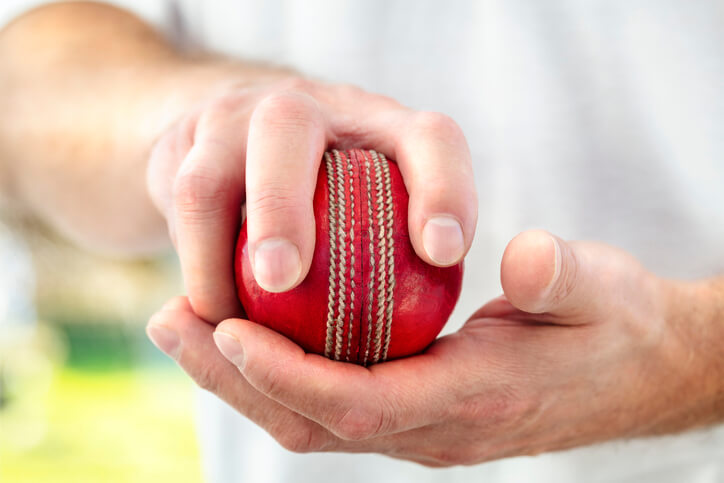A guide to cricket slang terms
28 April 2025

Whether you’re a cricket beginner or a regular player, cricket slang can be confusing, all the same.
There are so many obscure cricket phrases that it can be difficult to keep up sometimes, and you may feel like you need to add a glossary to your kit bag.
Fear not, though – we’ve put together a list of cricket slang terms for you to learn so you can focus on enjoying the game without worrying that you don’t understand what people are talking about!
Our glossary of cricket slang terms
Baggy green
This is the term used for the dark green cap worn by the Australian cricket team. The Australian national team has worn the baggy green since the early 1900s, and it is a symbol of national pride.
Beamer
A beamer is a delivery that passes above the batter’s waist before it hits the ground. This is considered a very dangerous delivery. It reduces the bowler’s amount of control and often results in the batter being struck by the ball. As such, it’s illegal in cricket and can result in a no-ball being called.
If a bowler delivers a beamer twice, they can be barred from bowling for the rest of the game. So, if you’re a bowler, avoid beamers at all costs.
Bouncer (chin music)
Originally a baseball slang term, “chin music” refers to a bowling strategy in which bouncers target the batter’s chin or throat. The balls rise with significant speed from the pitch, so they’re tough to hit and arguably even harder to bowl.
A bouncer isn’t technically illegal, but if you deliver too many, you could get a warning from the umpire.
Castled/Skittled
To ‘skittle out’ is to dismiss a batter very quickly. Castled is generally used when the batter is beaten by a yorker (see below).
Cow corner
This is the area of the field where the batter is least likely to hit the ball. The cow corner’s location depends on whether the batter is left or right-handed. However, it’s generally the deep part of the field on the batter’s leg side.
Because batters rarely hit the ball into this area, fielders often avoid it and utilise other spaces. Hence the term – an area of the field so deserted and undisturbed that cows could graze there happily.
Dolly
In cricket slang terms, a dolly is basically a very easy catch. For example, if the batter only glances the ball with the side of his bat and it pops into the air, it could be classed as a dolly if the fielder only has to move slightly to make the catch.
The term was most famously used in 1993 when England’s Mike Gatting dropped a dolly during a match against India.
Duck/Golden duck
A ‘duck’ is perhaps the best-known cricket slang term. This refers to when a batter is dismissed without scoring. A ‘golden duck’ is when they are dismissed by the first ball.
Jaffa
This is an unplayable delivery to a batter that doesn’t even need to get them out.
LBW
LBW (leg before wicket) is a means of dismissing a batter. This is used as a means of dismissal when the umpire believes a batter’s body part (usually the leg) has impeded the ball’s path when it was clearly going to hit the wicket.
Interested in how top commentators analyse such moments? Check out this article on the best female cricket commentators.
Leg spin
Sometimes referred to as a leggie, a leg spin is a form of spin bowling. A bowler must bowl with their right arm whilst creating a spin action with their wrist to achieve a leg spin. This causes the ball to spin from left to right, away from the leg of a right-handed batter.
Well-known masters of this technique include Bernard Bosanquet (credited with inventing the googly) and the late, great Shane Warne.
On-side/Off-side
On and off-side refer to the two halves of the pitch. The off-side is the half of the pitch in front of the batter’s body.
This is the right half of the pitch for a right-handed batter and vice versa for a left-handed batter. On-side is the half of the pitch behind the batter when they’re making a swing.
Slower ball
A slower ball is generally delivered by a fast bowler, ironically enough. The reason it’s called a slower ball is because it’s delivered with a medium pace, which can deceive the batter and make them hit the ball too early. When this happens, it allows the fielders to get under the high ball for an easy out.
Swing/Reverse swing
Swing bowling is a common form of delivery among fast bowlers. Fielders will polish just one side of the ball, so it’s worn on one side and shiny on the other. This enables them to swing effectively, as the air will travel faster over the shiny side than the worn side. Therefore, the ball will curve in the air.
Reverse swing is a lot more complicated. Basically, it’s the act of making the ball curve the opposite way it would with swing bowling.
There are many theories about how this is achieved, but generally, it’s through atmospheric conditions and bowling with an older ball. Fast-bowling Pakistan international Sarfaraz Nawaz invented this method.
Tail ender
The last batters in a team, usually the bowlers (numbers 8-11), are referred to as the tail. This is because the more skilled batters have been and gone. Therefore, a tail ender is one of these players, specifically numbers 10 and 11.
Toe-crushers
Toe-crushers is another term for a yorker (see below). It describes an in-swinging yorker and was commonly used by commentators in the 1990s to describe the bowling from Pakistan’s Waqar Younis and Wasim Akram (see swing/reverse swing).
Yorker
This term is used when the ball hits the cricket pitch near the batter’s feet during the bowler’s delivery.
Yorkers are notoriously difficult for batters to deal with. If a batter adopts a normal stance during the delivery, they may raise the bat too high when the ball lands on the pitch.
However, if they spot a yorker in time, they will jam their bat into the ground in a defensive stance to deal with the delivery.
The origin of this term is still debated today. Some people believe it originated in Yorkshire, while others suggest it is derived from the term “to pull a Yorkshire.” This slang term was used predominantly in the 18th century, meaning to deceive someone.
Specialist cricket insurance through Insure4Sport
Now you’re well-versed with the cricket terms you may hear during a match, you’re ready to get back out onto the pitch! Before you play your next cricket game, however, you may want to consider getting specialist cricket insurance.
Specialist cricket insurance through Insure4Sport can help protect you against third-party claims, theft, loss or damage to any sports equipment you own, and even loss of earnings should you suffer a personal injury that results in your inability to work.
Get a quote online for specialist cricket insurance through Insure4Sport today.
Please note the information provided on this page should not be taken as advice and has been written as a matter of opinion. For more on insurance cover and policy wording, see our homepage.
Got a question? Call our UK call centre 0800 158 5530
©Copyright Ripe Thinking Limited 2025.
Insure4Sport® is a registered trademark and a trading name of Ripe Insurance Services Limited which is Authorised and Regulated by the Financial Conduct Authority No.313411. Registered office: One Stockport Exchange, Railway Road, Stockport, United Kingdom, SK1 3SW. Registered in England No. 04507332.
